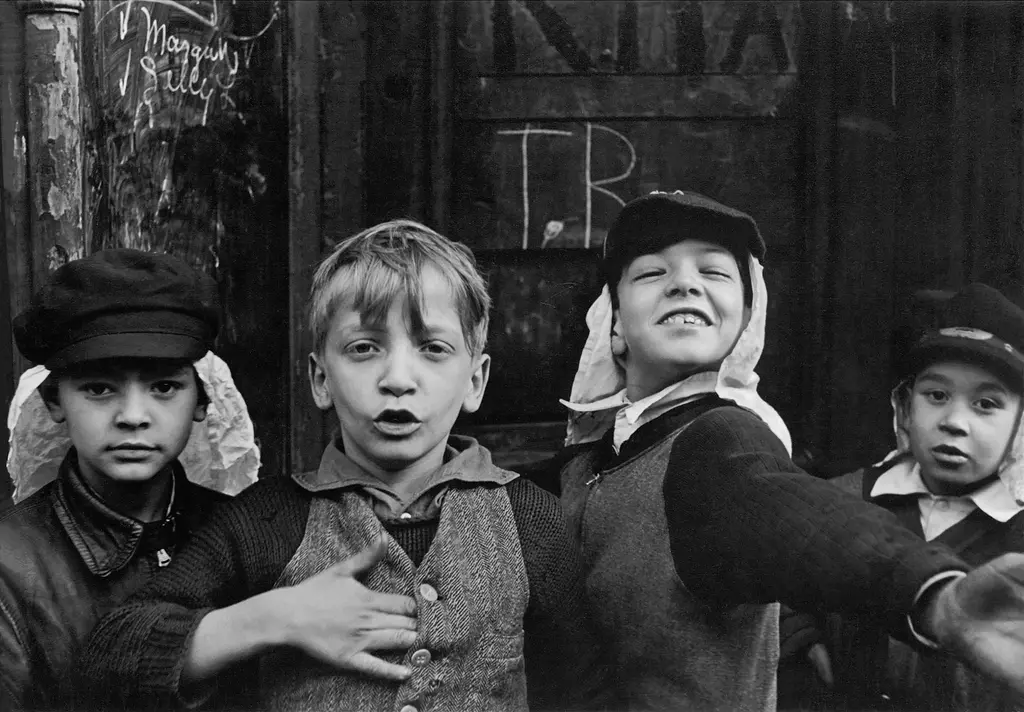Helen Levitt’s intimate scenes of 20th century New York life
- Text by Miss Rosen
- Photography by Helen Levitt

Hailing from Bensonhurst, Brooklyn, Helen Levitt (1913–2009) was a New York original. The daughter of Russian Jewish émigrés, Levitt rose to become one the greatest street photographers of the 20th century.
“In a genre dominated by men at the time, Levitt created an outstanding body of work that spans more than six decades and encompasses images, films and books,” says Anna Dannemann, Senior Curator at The Photographers’ Gallery, who collaborated with curator Walter Moser and the Albertina Museum in Vienna, on the new exhibition, Helen Levitt: In the Street.
The exhibition, along with the new book Helen Levitt, offer a look at street life in working-class communities around New York, which she began photographing in 1936 after meeting Henri Cartier-Bresson. Drawn to the spectacle of everyday life, Levitt embraced the passion and pathos of the community — a time when kids transformed the streets into their playground.

New York, 1978, © Film Documents LLC, courtesy Galerie Thomas Zander, Cologne
“Levitt’s photographs are spellbinding, full of real events that appear as almost more present and larger than life,” says Dannemann. “Her images don’t follow the rules of documentary photography but instead focus on emotions, happenstances and irrationalities.”
Drawing inspiration from Cartier-Bresson, Walker Evans, avant-garde cinema, social realism, and slapstick comedies, Levitt’s work is poetic in the truest sense of the word. “Her images thrive through contradictions, a complexity that allows for differences to exist simultaneously,” Dannemann observes.

New York, 1973 © Film Documents LLC, courtesy Galerie Thomas Zander, Cologne

New York, 1940 © Film Documents LLC, courtesy Galerie Thomas Zander, Cologne
When photographing adults, Levitt delights in depicting them liberated from the confines of polite society, creating powerful psychological portraits infused with empathy. Levitt manages to find expressions of her subject’s inner child through unexpected moments of release.
Although less famous than her contemporaries, Levitt was able to establish a career working as both a photographer and later a cinematographer. From 1945 to 1966, Levitt partnered with filmmaker Janice Loeb and writer James Agee to create In the Street.
Shot on the streets of Spanish Harlem, the ten-minute experimental documentary film is considered a key precursor to the cinéma vérité of the 1960s. Composed of a series of brief sequences without narration or soundtrack, the film is a pure, cinematic expansion of life inside Levitt’s photographs.

New York, 1971 © Film Documents LLC, courtesy Galerie Thomas Zander, Cologne
It opens with a written prologue by Agee, which gives voice to Levitt’s vision: “The streets of the poor quarters of great cities are, above all, a theatre and a battleground. There, unaware and unnoticed, every human being is a poet, a masker, a warrior, a dancer and in his innocent artistry he projects, against the turmoil of the street, an image of human existence.”
Offering a window into a world that largely no longer exists, Levitt’s work continues to resonate decades after it was made. “They show what I would describe as deeply human,” says Dannemann.
“The children’s play in the streets reminds us of a freedom from norms, constraints, and the capitalist system. There is something to be learned from observing these interactions and games on the street, and Helen Levitt lets the rest of us in on it.”

New York, 1980 © Film Documents LLC, courtesy Galerie Thomas Zander, Cologne

New York, 1938, © Film Documents LLC, courtesy Galerie Thomas Zander, Cologne

New York, 1982, © Film Documents LLC courtesy Galerie Thomas Zander, Cologne

New York, ca. 1945 © Film Documents LLC, courtesy Galerie Thomas Zander, Cologne
Helen Levitt: In the Street is on view at The Photographers’ Gallery, London from October 15, 2021 – February 13, 2022.
Enjoyed this article? Like Huck on Facebook or follow us on Twitter and Instagram.
You might like

“Humanity’s big threat is our disconnect from nature”: Craig Richards and Chris Levine in conversation
Lighting up — With Houghton Festival collaborating with artist Chris Levine in its most recent edition, we sat down with the light artist and the festival’s creative director Craig Richards to chat about their new installations, and the role of art and music in tumultuous times.
Written by: Isaac Muk

Three heart wrenching poems from Gaza
Writings that narrate — With Gaza’s population facing starvation, we are handing over our website to Yahya Alhamarna, a displaced poet and student in Gaza, who shares some of his recent poetry, and explains why writing is so important to him.
Written by: Yahya Alhamarna

Throwback portraits of the UK’s first punks
Punks 1978-1980 — While working as a photographer in the army, Wayne “Spike” Large would moonlight as a punk on the weekends. His new photobook revisits the characters that he captured from the genre’s heyday.
Written by: Miss Rosen

Will internet age verification actually work?
VPN Summer — With the Online Safety Act coming into force over the weekend, the UK woke up to find pornography, but also any content deemed “harmful” hidden behind an ID wall. But young people are far too tech savvy to be deterred, explains newsletter columnist Emma Garland, who also warns of the dangers of mass data harvesting.
Written by: Emma Garland

Love and rage at the record shattering London Trans+ Pride 2025
Dismantle the cis-tem — With over 100,000 attendees, the Saturday march was the largest trans pride event ever in world history. Cheer Up Luv’s Eliza Hatch captured the action, and recounts its powerful energy.
Written by: Eliza Hatch / @cheerupluv

New documentary revisits NYC’s ’90s skateboarding golden age via the lens of Supreme
Empire Skate — The 30 for 30 documentary premiered in June, exploring how the brand evolved from a Lafayette skate shop into a global streetwear giant.
Written by: Isaac Muk

